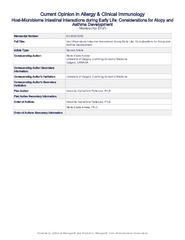Host–microbiome intestinal interactions during early life: considerations for atopy and asthma development
Permanent lenke
https://hdl.handle.net/10037/21214Dato
2020-04Type
Journal articleTidsskriftartikkel
Peer reviewed
Sammendrag
Purpose of review: The body's largest microbial community, the gut microbiome, is in contact with mucosal surfaces populated with epithelial, immune, endocrine and nerve cells, all of which sense and respond to microbial signals. These mutual interactions have led to a functional coevolution between the microbes and human physiology. Examples of coadaptation are anaerobes Bifidobacteria and Bacteroides, which have adjusted their metabolism to dietary components of human milk, and infant immune development, which has evolved to become reliant on the presence of beneficial microbes. Current research suggests that specific composition of the early-life gut microbiome aligns with the maturation of host immunity. Disruptions of natural microbial succession patterns during gut colonization are a consistent feature of immune-mediated diseases, including atopy and asthma.
Recent findings: Here, we catalog recent birth cohorts documenting associations between immune dysregulation and microbial alterations, and summarize the evidence supporting the role of the gut microbiome as an etiological determinant of immune-mediated allergic diseases.
Summary: Ecological concepts that describe microbial dynamics in the context of the host environment, and a portray of immune and neuroendocrine signaling induced by host–microbiome interactions, have become indispensable in describing the molecular role of early-life microbiome in atopy and asthma susceptibility.


 English
English norsk
norsk